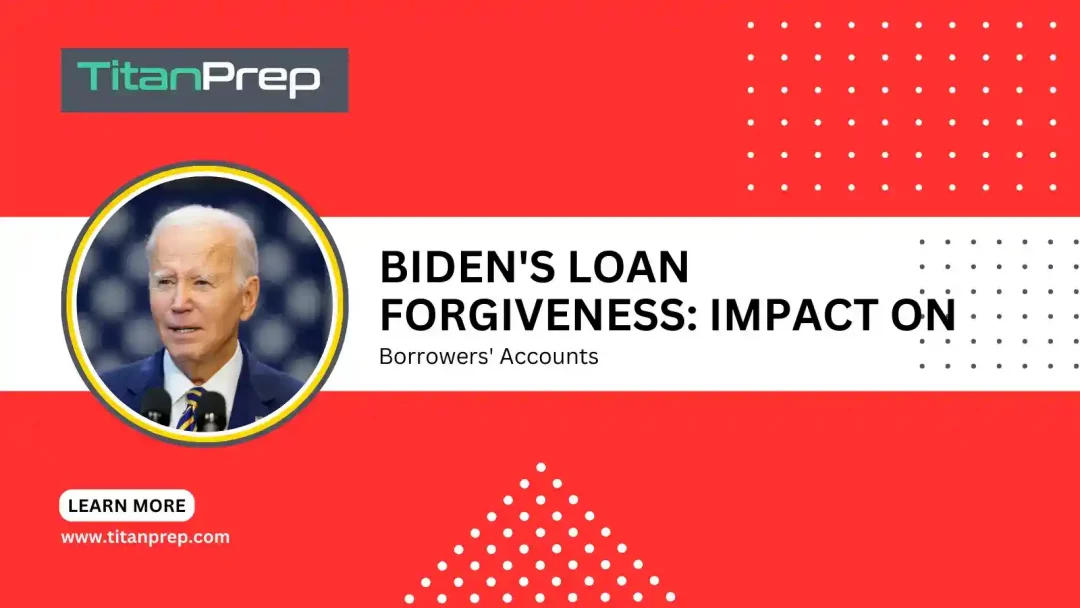Biden’s Loan Forgiveness: Impact on Borrowers’ Accounts
Millions of federal student loan borrowers, eagerly awaiting news about their debt relief, now find themselves in the phase of patiently anticipating the reduction of their loan balances. President Joe Biden recently unveiled his plan to forgive up to $10,000 in federal student debt per borrower, with Pell Grant recipients eligible for up to $20,000 in forgiveness. Individuals earning under $125,000 per year, or married couples and heads of households earning less than $250,000 per year, qualify for this debt cancellation. In this article, we will delve into when borrowers can expect to see this forgiveness reflected in their accounts.
The Struggle of Student Loans
Before delving into the specifics of Biden’s plan, let us first acknowledge the difficulties that student loan borrowers face. For many people, the pursuit of higher education comes at a high cost. Student loan debt can quickly accumulate, leaving borrowers with a financial burden that can last for years, if not decades, after graduation.
The burden of student loans can have an impact on many aspects of borrowers’ lives. It has an impact on their ability to save for future goals such as purchasing a home or starting a family. Furthermore, student loan debt can stymie career opportunities by making borrowers feel obligated to pursue higher-paying jobs rather than following their passions.
Understanding Biden’s Loan Forgiveness Plan
President Biden has proposed a loan forgiveness plan to help borrowers who are drowning in student loan debt. While the specifics of the plan are still being debated, understanding the key components and potential implications is beneficial.
1. Income-Driven Repayment and Loan Forgiveness
One component of Biden’s strategy is to broaden income-driven repayment (IDR) options. Borrowers’ monthly loan payments are based on their income and family size under an IDR plan, making the payments more manageable. Furthermore, the plan proposes lowering the percentage of discretionary income required for loan repayment and extending the repayment period, easing borrowers’ financial burden.
Furthermore, Biden’s loan forgiveness plan aims to make the loan forgiveness process easier for IDR participants. Borrowers who choose IDR plans may currently be eligible for loan forgiveness after 20 or 25 years of consistent payments. The proposed plan aims to shorten the timeline for forgiveness, potentially providing relief to borrowers sooner.
2. Public Service Loan Forgiveness
Biden’s strategy also calls for the expansion of the Public Service Loan Forgiveness (PSLF) program. Borrowers who work in qualifying public service jobs and make 120 monthly payments are currently eligible for loan forgiveness under the PSLF program. However, due to complex eligibility requirements and implementation issues, the program has faced challenges and had limited success.
The proposed PSLF program expansion aims to simplify the forgiveness process, broaden the range of eligible jobs, and provide loan forgiveness options sooner. This expansion could be game changer for borrowers in public service professions, such as teachers, nurses, and government employees, who frequently earn less than their private-sector counterparts.
3. Specific Borrower Groups
President Biden’s plan addresses specific borrower groups with unique circumstances in addition to the broader loan forgiveness measures. Borrowers who attended for-profit colleges are one notable group. These institutions have come under fire for deceptive practices and for leaving students with significant debt and few job opportunities. By implementing targeted loan forgiveness measures, the plan proposes to provide significant relief to these borrowers.
Individuals with disabilities are another group targeted by Biden’s plan. The plan aims to make it easier for borrowers with severe disabilities to discharge their student loan debt, providing them with much-needed financial relief.
When Will Borrowers of Federal Student Loans See Biden’s Forgiveness?
To take advantage of this forgiveness, the majority of federal student loan borrowers whose income meets the requirements must submit an application form detailing their income. The complexity of the application form, as well as any potential legal challenges, can lengthen the process. While the form is expected to be available in early October, the relief is expected to be available within four to six weeks of submitting the application. To ensure forgiveness by the end of this year, the application must be submitted by November 15, 2022, according to the Federal Student Aid website.
There may be qualified borrowers whose forgiveness will be expedited. Because their income data is already on file with the Department of Education, those enrolled in income-driven repayment plans will automatically receive student loan forgiveness. This automatic relief is expected to benefit approximately 8 million borrowers. To stay informed, federal student loan borrowers can sign up for notifications on the Department of Education’s subscription page once the forgiveness process officially begins and the application form is available. According to the Federal Student Aid website, the deadline to apply for forgiveness is December 31, 2023.
Borrowers Who Continued Loan Payments During the Payment Pause:
Borrowers who continued to make loan payments during the payment pause, which was implemented on March 13, 2020, may be eligible for a refund. Several borrowers have already reported contacting their lenders, requesting refunds, and receiving payments in a matter of days. Although this action may temporarily increase the loan balance, these balances are very likely to be canceled after applying for forgiveness.
Managing Student Debt After Being Accepted for Forgiveness:
There are several options available to borrowers who still have some student debt after the forgiveness is applied. To begin, experts in the field Meagan Landress and Mark Kantrowitz both recommend taking advantage of the extended payment and interest pause on federal student loans, which now extends through December 2022.
Borrowers who can allocate these saved funds towards their savings or paying off higher-interest debts, such as credit cards, should still make their monthly student loan payments. This approach aids borrowers in developing a regular payment habit and helps reduce the principal amount owed while interest charges are temporarily halted. In 2023, when payments and interest are anticipated to resume, borrowers with high-interest rates may benefit from enrolling in autopay, which offers a 0.25% reduction in interest rates as an incentive.
Refinancing federal loans is another viable option, particularly for those who are burdened by high interest rates. Borrowers can consolidate their loan payments in order to obtain a lower interest rate and a new loan term. It should be noted that refinancing federal loans with a private lender removes federal loan protections such as income-driven repayment plans, future forgiveness options, and deferment or forbearance options. Borrowers should therefore wait for Biden’s loan forgiveness before considering refinancing. To ensure a timely benefit, it is recommended that the forgiveness application be submitted as soon as it becomes available.
Consider Refinancing: Top Lending Options:
When considering refinancing options, borrowers should consider reputable lenders like SoFi, which provides a variety of protections such as unemployment protection, COVID-related forbearance, and loan deferment. SoFi also honors any previously established grace periods on refinanced loans. Earnest and CitizensTM lenders increase the chances of refinancing approval, with Earnest accepting applications from people with fair credit and CitizensTM allowing applicants to apply with a co-signer.
Conclusion:
Federal student loan borrowers are eagerly awaiting relief from their student debt burdens with President Biden’s student loan forgiveness plan now in motion. Borrowers can navigate the process effectively and make informed decisions about their loan repayment strategies if they understand the timelines and criteria for forgiveness. Remember to submit the forgiveness application as soon as possible, as deadlines apply, and use caution when considering refinancing options. Borrowers can take full advantage of this opportunity for financial freedom by leveraging available resources and staying up to date with Department of Education notifications.







Leave a Reply